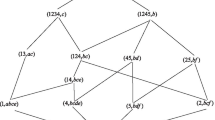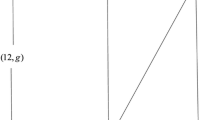Abstract
Concepts are basic units of human cognitive activities and concept based granule description is one of the possible ways to realize explainable AI through information granules. However, the existing types of concepts cannot work effectively when it is necessary to simultaneously investigate the common attributes and possible attributes of granules. In order to solve this problem, we propose common-possible concept analysis based on a granule description viewpoint. Concretely, common-possible concepts are proposed, which can concurrently describe the common attributes and possible attributes of granules. Then, a method to acquire common-possible concepts from formal contexts is described. Besides, the connections between common-possible concepts and the other types of concepts are explored. Analysis results show that common-possible concept analysis can effectively deal with a type of problems and provides some details of granules different from that of formal concepts and property oriented concepts.






Similar content being viewed by others
References
Bargiela A, Pedrycz W (2003) Granular computing: an introduction. Kluwer Academic Publishers, Dordrecht
Chen YH, Yao YY (2008) A multiview approach for intelligent data analysis based on data operators. Inf Sci 178:1–20
Davey BA, Priestley HA (2002) Introduction to lattices and order. Cambridge University Press, Cambridge
Djouadi Y, Prade H (2011) Possibility-theoretic extension of derivation operators in formal concept analysis over fuzzy lattices. Fuzzy Optim Decis Making 10(4):287–309
Dubois D, Dupin deSaintCyr F, Prade H (2007) A possibilty-theoretic view of formal concept analysis. Fundamenta Informaticae 75(1–4):195–213
Dubois D, Prade H (2009) Possibility theory and formal concept analysis in information systems. Proceedings of IFSA/EUSFLAT’09 Lisbon, Portugal, pp 1021–1026
Düntsch I, Gediga G (2002) Modal-style operators in qualitative data analysis. In: Proceedings of the 2002 IEEE international conference on data mining. IEEE Computer Society, Washington, D.C., pp 155–162
Fan SQ, Zhang WX, Xu W (2006) Fuzzy inference based on fuzzy concept lattice. Fuzzy Sets Sys 157(24):3177–3187
Fujita H, Gaeta A, Loia V, Orciuoli F (2019) Resilience analysis of critical infrastructures: a cognitive approach based on granular computing. IEEE Trans Cybern 49(5):1835–1848
Fujita H, Gaeta A, Loia V, Orciuoli F (2020) Hypotheses analysis and assessment in counter-terrorism activities: a method based on OWA and fuzzy probabilistic rough sets. IEEE Trans Fuzzy Sys 28 (5):831–845
Ganter B, Kuznetsov SO (2003) Hypotheses and version spaces, conceptual structures for knowledge creation and communication, Formal concept analysis: Mathematical foundations. Springer, Berlin, pp 83–95
Ganter B, Wille R (1999) Formal concept analysis: mathematical foundations. Springer, Berlin
Godin R, Missaoui R, Alaoui H (1995) Incremental concept formation algorithms based on Galois (concept) lattices. Comput Intell 11(2):246–267
King DB, Wertheimer M (2004) Max Wertheimer and Gestalt theory. Transaction Publishers, Piscataway
Lai HL, Zhang DX (2009) Concept lattices of fuzzy contexts: formal concept analysis vs rough set theory. Int J Approx Reason 50(5):695–707
Lang GM, Li QG, Cai MJ, Fujita H, Zhang HY (2019) Related families-based methods for updating reducts under dynamic object sets. Knowl Inf Sys 60(2):1081–1104
Lei Y, Luo M (2009) Rough concept lattices and domains. Ann Pure Appl Logic 159(33):333–340
Li JH, Yue R, Mei CL, Qian YH, Yang XB (2016) A comparative study of multigranulation rough sets and concept lattices via rule acquisition. Knowl Based Sys 91:152–164
Li JH, Huang CC, Qi JJ, Qian YH, Liu WQ (2017) Three-way cognitive concept learning via multi-granularity. Inf Sci 378:244–263
Li JH, Liu ZM (2020) Granule description in knowledge granularity and representation. Knowl Based Sys 203:106160
Liu KY, Yang XB, Fujita H, Liu D, Yang X, Qian YH (2019) An efficient selector for multi-granularity attribute reduction. Inf Sci 505:457–472
Liu KY, Yang XB, Yu HL, Fujita H, Chen XJ, Liu D (2020) Supervised information granulation strategy for attribute reduction. Int J Mach Learn Cybern 11(9):2149– 2163
Medina J (2012) Relating attribute reduction in formal, object-oriented and property-oriented concept lattices. Comput Math Appl 64(6):1992–2002
Nourine L, Raynaud O (1999) A fast algorithm for building lattices. Inf Process Lett 71:199–204
Pedrycz W (2018) Granular computing for data analytics: a manifesto of human-centric computing. IEEE/CAA J Automat Sinica 5(6):1025–1034
Qi JJ, Wei L, Yao YY (2014) Three-way formal concept analysis. Lect Notes Comput Sci 8818:732–741
Qi JJ, Qian T, Wei L (2016) The connections between three-way and classical concept lattices. Knowl Based Sys 91:143– 151
Qi JJ, Wei L, Wan Q (2019) Multi-level granularity in formal concept analysis. Gran Comput 4:351–362
Rodriguez-Jimenez JM, Cordero P, Enciso M, Mora A (2014) Negative attributes and implications in formal concept analysis. Procedia Comput Sci 31:758–765
Salehi S, Selamata A, Fujita H (2015) Systematic mapping study on granular computing. Knowl Based Sys 80:78–97
Shao MW, Liu M, Zhang WX (2007) Set approximations in fuzzy formal concept analysis. Fuzzy Sets Sys 158(23):2627– 2640
Shivhare R, Cherukuri AK (2017) Three-way conceptual approach for cognitive memory functionalities. Int J Mach Learn Cybern 8(1):21–34
Singh PK, Kumar CA (2014) Bipolar fuzzy graph representation of concept lattice. Inf Sci 288:437–448
Singh PK (2018) Medical diagnoses using three-way fuzzy concept lattice and their Euclidean distance. Comput Appl Math 37(3):3283–3306
Singh PK (2018) Concept learning using vague concept lattice. Neural Process Lett 48(1):31–52
Singh PK (2019) Bipolar fuzzy concept learning using next neighbor and Euclidean distance. Soft Comput 23(12):4503– 4520
Wang X, Zhang W (2008) Relations of attribute reduction between object and property oriented concept lattices. Knowl Based Sys 21(5):398–403
Wei L, Qian T (2015) The three-way object oriented concept lattice and the three-way property oriented concept lattice. In: Proceedings of the 2015 international conference on machine learning and cybernetics, pp 854–859
Wei L, Wan Q (2016) Granular transformation and irreducible element judgment theory based on pictorial diagrams. IEEE Trans Cybern 46(2):380–387
Wei L, Liu L, Qi JJ, Qian T (2020) Rules acquisition of formal decision contexts based on three-way concept lattices. Inf Sci 516:529–544
Wille R (1982) Restructuring lattice theory: an approach based on hierarchies of concepts. In: Rival I (ed) Ordered sets. Reidel, Dordrecht-Boston, pp 445–470
Wu XD, Zhang CQ, Zhang SC (2004) Efficient mining of both positive and negative nssociation rules. ACM Trans Inf Sys 22(3):381–405
Xu WH, Li WT (2016) Granular computing approach to two-way learning based on formal concept analysis in fuzzy datasets. IEEE Trans Cybern 46(2):366–379
Yang X, Zhang YY, Fujita H, Liu D, Li TR (2020) Local temporal-spatial multi-granularity learning for sequential three-way granular computing. Inf Sci 541:75–97
Yang X, Li TR, Liu D, Fujita H (2020) A multilevel neighborhood sequential decision approach of granular computing. Inf Sci 538:119–141
Yao YY (2001) Modeling data mining with granular computing. In: Proceedings of the 25th annual international computer software and applications conference. Chicago, pp 638–643
Yao YY (2004) A comparative study of formal concept analysis and rough set theory in data analysis, 4th International conference on rough sets and current trends in computing. Lect Notes Comput Sci 3066:59–68
Yao YY (2004) Concept lattices in rough set theory. In: Proceedings of 23rd international meeting of the North American fuzzy information processing society, pp 796–801
Yao YY (2016) Rough-set analysis: Interpreting RS-definable concepts based on ideas from formal concept analysis. Inf Sci 346–347:442–462
Yao YY (2017) Interval sets and three-way concept analysis in incomplete contexts. J Mach Learn Cybern 8(1):3–20
Yao YY (2018) Three-way decision and granular computing. Int J Approx Reas 103:107–123
Yu HY, Li QG, Cai MJ (2018) Characteristics of three-way concept lattices and three-way rough concept lattices. Knowl-Based Syst 146:181–189
Zadeh LA (1997) Towards a theory of fuzzy information granulation and its centrality in human reasoning and fuzzy logic. Fuzzy Sets Sys 19:111–127
Zhang WX, Qiu GF (2005) Uncertain decision making based on rough sets. Tsinghua University Press, Beijing
Zhao XR, Miao DQ, Fujita H (2021) Variable-precision three-way concepts in L-contexts. Int J Approx Reas 130:107–125
Zhi HL, Li JH (2019) Granule description based on positive and negative attributes. Gran Comput 4:337–350
Zhi HL, Li JH (2019) Granule description based knowledge discovery from incomplete formal contexts via necessary attribute analysis. Inf Sci 485:347–361
Zhi HL, Qi JJ, Qian T, Wei L (2019) Three-way dual concept analysis. Int J Approx Reas 114:151–165
Zhi HL, Qi JJ, Qian T, Ren RS (2020) Conflict analysis under one-vote veto based on approximate three-way concept lattice. Inf Sci 516:316–330
Zhong N, Yau SS, Ma JH, Shimojo S (2015) Brian informatics-based big data and the wisdom web of things. IEEE Intell Sys 30(5):2–7
Acknowledgements
This work was supported by the National Natural Science Foundation of China (Nos. 61772021, 11801440 and 61976244), Natural Science Basic Research Program of Shaanxi (Program No. 2021JM-141) and the Fundamental Research Funds for the Universities of Henan Province (Program No. NSFRF210318).
Author information
Authors and Affiliations
Corresponding author
Ethics declarations
Conflict of Interest
The authors declare that they have no conflict of interest.
Additional information
Publisher’s note
Springer Nature remains neutral with regard to jurisdictional claims in published maps and institutional affiliations.
Rights and permissions
About this article
Cite this article
Zhi, H., Qi, J. Common-possible concept analysis: A granule description viewpoint. Appl Intell 52, 2975–2986 (2022). https://doi.org/10.1007/s10489-021-02499-9
Accepted:
Published:
Issue Date:
DOI: https://doi.org/10.1007/s10489-021-02499-9




